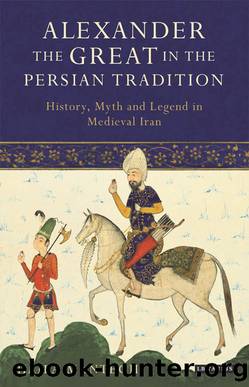Alexander the Great in the Persian Tradition: History, Myth and Legend in Medieval Iran by Haila Manteghi

Author:Haila Manteghi [Manteghi, Haila]
Language: eng
Format: epub
Tags: Early history: c 500 to c 1450/1500, Social Science, Social & cultural history, Literary Criticism, Ancient & Classical, Fairy Tales; Folk Tales; Legends & Mythology, Historiography, Persian Empire, Middle Eastern, Iran, Folklore, myths & legends, Middle East, early & medieval, Medieval, Classical history/classical civilisation, Social History, Literary studies: Classical, Ancient Greece, Islamic studies, Europe, General, Ancient, History, Folklore & Mythology, Fiction, Middle Eastern history
ISBN: 9781786723666
Google: b9WLDwAAQBAJ
Publisher: Bloomsbury
Published: 2018-02-28T20:39:42+00:00
Alexander in the Dhū'l-Qarnayn Tradition
In the Islamic tradition, Alexander is identified with the prophet DhÅ«'l-Qarnayn mentioned in the Qur'Än (SÅ«rah 18:82). This identification created an important branch of Alexander literature in Arabic, and consequently in Persian, which Doufikar-Aerts appropriately calls âthe DhÅ«'l-Qarnayn traditionâ.63 This genre, in contrast to other branches of Alexander literature, which are mainly based on Byzantine and Greek works (such as Alexander wisdom literature and the Alexander Romance tradition), represents a separate and independent development within the framework of Arabic literature itself.64 The main motif of the DhÅ«'l-Qarnayn tradition, which can also be partially traced back to the Alexander Romance tradition, is the wall built by the conqueror against Gog and Magog (mentioned in the Qur'Än, SÅ«rah 18:92â8).
More important than the identification of DhÅ«'l-Qarnayn himself, or the reliability of traditions ascribed to him, is the fact that in the Islamic world, Alexander was identified as the prophet DhÅ«'l-Qarnayn in both historical and Romance traditions from the ninth century AD onwards. According to Doufikar-Aerts, the DhÅ«'l-Qarnayn tradition reflects a development that can be traced back to previous Middle Eastern Alexander traditions (such as the Syriac Christian legend), alongside sub-recension γ of the Pseudo-Callisthenes and the oldest Arabic commentaries on the Qur'Än (for example, 18:82â98).65
The first episode of the IqbÄlnÄma deals with the question of why Alexander was identified as DhÅ«'l-Qarnayn (Bicorn). NiáºÄmÄ« gives seven possible reasons, which take into account various connotations of the term qarn:
(1)Alexander is Dhū'l-Qarnayn because he reached both extremes (qarn) of the world: the East and the West.66
(2)Alexander is Dhū'l-Qarnayn because he could fight with both hands (qarn as arm/hand).
(3)Alexander is Dhū'l-Qarnayn because he fastened his hair (qarn as hair) into braids on both sides of his head.67
(4)Alexander is Dhū'l-Qarnayn because he dreamt that he held the two poles of the sun (qarn as pole).
(5)Alexander is Dhū'l-Qarnayn because his life spanned two different centuries (qarn as century).
(6)According to AbÅ« Maâshar (Albumasar) in his book al-UlÅ«f (Book of Thousands)68 when Alexander died, due to the great love the Greeks felt for him, they drew or painted a portrait of him with two angels bearing horns on either side of his head. When the Arabs saw this painting they incorrectly thought that these angels were Alexander himself, and thus came to call him âthe Two-Horned Oneâ (á¹£Äḥib daw qarn).69
(7)Alexander was called âthe Two-Horned Oneâ because his ears were overlarge;70 this was told to NiáºÄmÄ« by âa wise manâ (khudÄvand-i hÅ«sh).
Download
This site does not store any files on its server. We only index and link to content provided by other sites. Please contact the content providers to delete copyright contents if any and email us, we'll remove relevant links or contents immediately.
| Bahrain | Egypt |
| Iran | Iraq |
| Israel & Palestine | Jordan |
| Kuwait | Lebanon |
| Oman | Qatar |
| Saudi Arabia | Syria |
| Turkey | United Arab Emirates |
| Yemen |
Empire of the Sikhs by Patwant Singh(22977)
The Wind in My Hair by Masih Alinejad(5034)
Rise and Kill First by Ronen Bergman(4705)
The Templars by Dan Jones(4629)
The Rape of Nanking by Iris Chang(4139)
12 Strong by Doug Stanton(3509)
Blood and Sand by Alex Von Tunzelmann(3140)
Babylon's Ark by Lawrence Anthony(2622)
The History of Jihad: From Muhammad to ISIS by Spencer Robert(2572)
No Room for Small Dreams by Shimon Peres(2320)
The Turkish Psychedelic Explosion by Daniel Spicer(2314)
Gideon's Spies: The Secret History of the Mossad by Gordon Thomas(2305)
Inside the Middle East by Avi Melamed(2305)
Arabs by Eugene Rogan(2262)
The First Muslim The Story of Muhammad by Lesley Hazleton(2219)
Come, Tell Me How You Live by Mallowan Agatha Christie(2212)
Bus on Jaffa Road by Mike Kelly(2103)
Kabul 1841-42: Battle Story by Edmund Yorke(1986)
1453 by Roger Crowley(1967)
